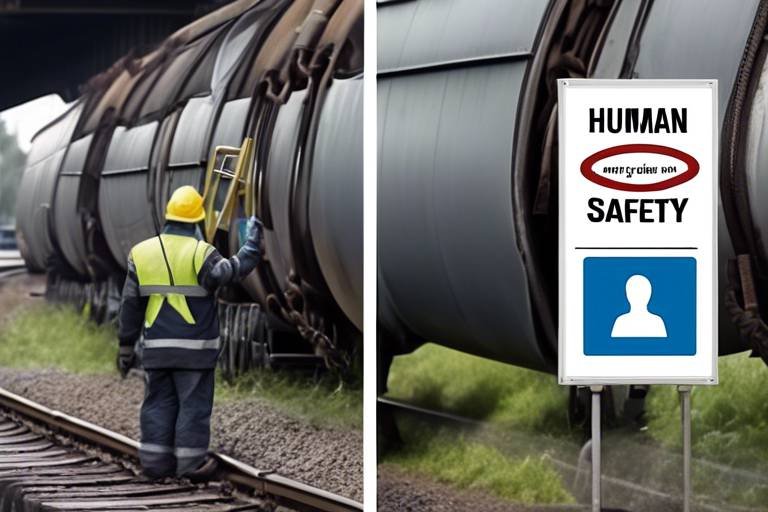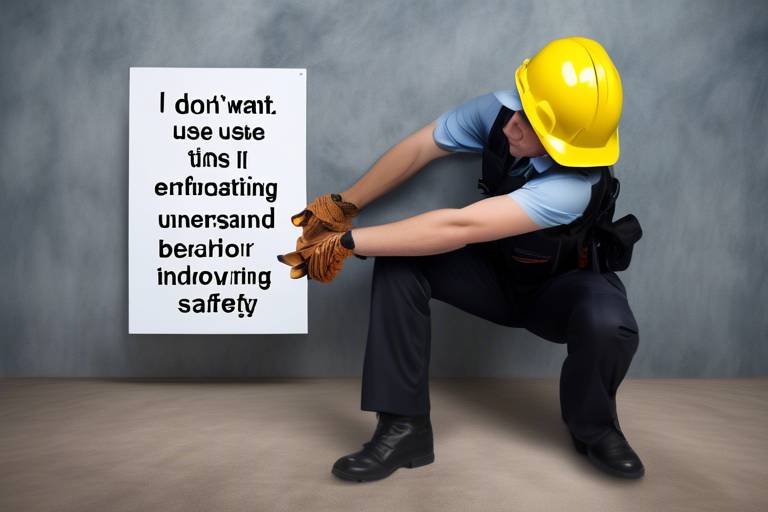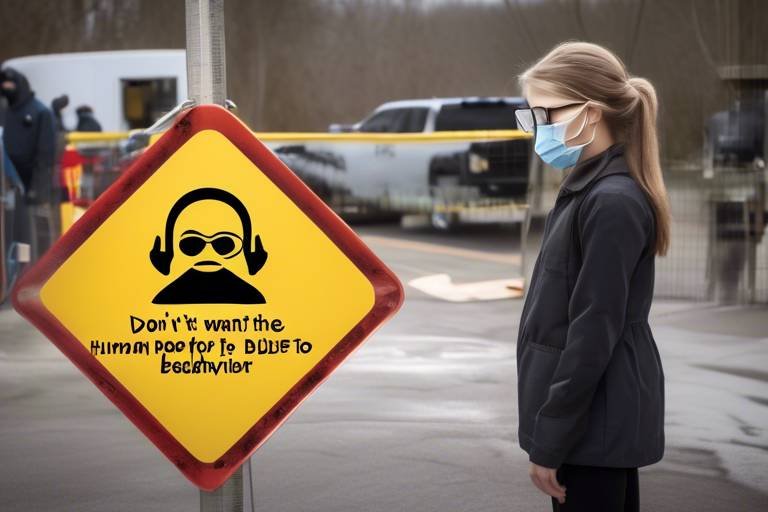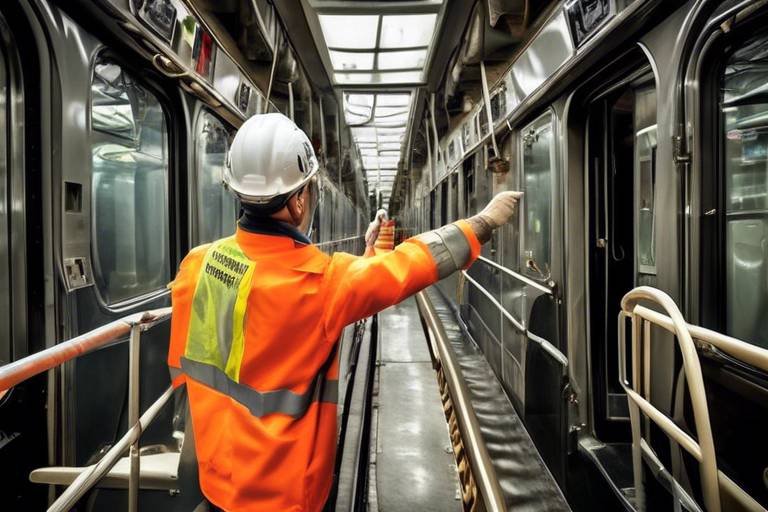The Influence of Human Behavior on Safety Measures
In today's world, safety measures are more important than ever. However, have you ever stopped to think about how human behavior influences these protocols? It's fascinating to realize that our actions, decisions, and perceptions play a significant role in how safety measures are developed and implemented. From the way we assess risks to how we respond in emergencies, our behaviors can either enhance or undermine safety efforts. In this article, we will explore the intricate relationship between human behavior and safety measures, shedding light on psychological factors, decision-making processes, and the importance of training in fostering a culture of safety.
Understanding how individuals perceive risks is crucial for developing effective safety measures. Our brains are wired to assess threats, but this process is often influenced by cognitive biases and emotional factors. For instance, have you ever noticed how some people are more afraid of flying than driving, despite statistics showing that flying is safer? This discrepancy highlights the importance of risk perception in shaping our responses to safety protocols. Cognitive biases, such as the availability heuristic, can lead us to overestimate the likelihood of rare events while underestimating common risks. By recognizing these biases, organizations can tailor their safety messaging to resonate better with individuals, ultimately leading to improved compliance.
Training plays a vital role in shaping safe behaviors. It's not just about knowing the rules; it's about instilling a safety-first mindset that becomes second nature. Different training methodologies can be employed to ensure that safety-conscious habits are effectively instilled among employees and individuals. For example, hands-on training allows participants to engage directly with safety equipment and procedures, while simulation exercises can prepare them for real-life scenarios. The key is to create a training environment that encourages open communication and active participation, fostering a sense of ownership over safety practices.
Behavioral economics provides valuable insights into how economic incentives and social influences impact safety-related decisions. It’s intriguing to consider how our financial motivations can sometimes clash with our safety instincts. For instance, when faced with tight budgets, companies might cut corners on safety training, believing they can save money without compromising safety. However, this short-sighted approach can lead to dire consequences. By understanding the interplay between financial motivations and safety compliance, organizations can create more effective incentive structures that encourage safe practices without sacrificing quality.
Various incentive structures can encourage adherence to safety protocols. For example, offering monetary rewards for teams that maintain an accident-free record can motivate employees to prioritize safety. Additionally, recognition programs that celebrate individuals or teams for their commitment to safety can foster a positive safety culture. By understanding what motivates employees, organizations can design incentives that resonate and promote a culture of safety.
Social norms significantly shape individual behavior, especially in the workplace. When employees see their peers adhering to safety measures, they are more likely to follow suit. This phenomenon is often referred to as the bandwagon effect, where individuals adopt behaviors because they see others doing the same. Fostering a safety-oriented culture is essential, as it encourages employees to hold each other accountable for their actions. By promoting positive safety behaviors through peer influence, organizations can create an environment where safety is prioritized and celebrated.
High-pressure situations can lead to poor decision-making, often resulting in compromised safety. Stress and time constraints can cloud judgment, making it challenging for individuals to follow safety protocols effectively. Imagine being in a fire drill where the alarm is blaring, and everyone is rushing to exit. In such moments, it’s easy to overlook critical safety procedures. Organizations must recognize these challenges and implement strategies to help employees make sound judgments even under pressure. Training that simulates high-stress scenarios can prepare individuals to respond appropriately, ensuring that safety remains a priority.
The culture within an organization significantly influences employee behavior regarding safety. A strong safety culture promotes open communication, encourages reporting of unsafe conditions, and prioritizes employee well-being. Leadership plays a crucial role in shaping this culture. When leaders demonstrate a genuine commitment to safety, it sets the tone for the entire organization. Employees are more likely to engage in safe practices when they see their leaders prioritizing safety through their actions and communication.
Effective leadership is essential for promoting a robust safety culture. Leaders must model safe behaviors and communicate the importance of safety in every aspect of the organization. This includes providing resources for training, encouraging feedback, and recognizing safe practices. When leaders actively participate in safety initiatives, it reinforces the message that safety is a shared responsibility.
Clear communication is vital for safety awareness. Organizations need to convey safety information effectively to engage employees in safety initiatives. Utilizing various communication channels, such as meetings, newsletters, and digital platforms, can ensure that safety messages reach everyone. Additionally, creating an open forum for discussing safety concerns can empower employees to voice their thoughts and contribute to a safer workplace.
- What is the importance of human behavior in safety measures?
Human behavior significantly influences the effectiveness of safety protocols, as it determines how individuals perceive risks and respond to safety measures. - How can organizations improve safety training?
Organizations can enhance safety training by incorporating hands-on exercises, simulations, and fostering an environment of open communication. - What role do incentives play in promoting safety?
Incentives can motivate employees to adhere to safety protocols by rewarding safe practices and recognizing individuals or teams for their commitment to safety. - How does organizational culture impact safety?
A strong safety culture encourages open communication and prioritizes employee well-being, significantly influencing employee behavior regarding safety.

The Psychology of Risk Perception
Understanding how individuals perceive risks is crucial for developing effective safety measures. Our brains are wired to assess danger, but this process is often influenced by cognitive biases and emotional factors that can distort our judgment. For instance, when faced with a potential hazard, such as a slippery floor, our immediate reaction might be to weigh the likelihood of slipping against our past experiences. If we've never fallen before, we might underestimate the risk, thinking, "It won't happen to me." This is a classic example of the optimism bias, where people believe they are less likely to experience negative events compared to others.
Moreover, factors like availability heuristic come into play. This cognitive bias leads us to judge the probability of events based on how easily examples come to mind. If we recently heard about a workplace accident, we might overestimate the risks associated with our job, even if statistically, our workplace is safe. This can create a paradox where heightened awareness of risk can lead to anxiety, causing individuals to either overreact or ignore safety protocols altogether.
Emotions also play a significant role in risk perception. Fear can cloud judgment, leading to hasty decisions that may not align with actual safety practices. For example, during an emergency, individuals may panic and disregard established evacuation procedures, opting instead for the nearest exit without considering potential hazards. This underscores the importance of training and education in safety protocols, as they can help individuals manage their emotions and make more informed decisions under pressure.
To illustrate these concepts further, let’s take a look at a simple table that outlines some common cognitive biases affecting risk perception:
| Cognitive Bias | Description |
|---|---|
| Optimism Bias | The belief that one is less likely to experience negative events compared to others. |
| Availability Heuristic | Judging the probability of events based on how easily examples come to mind. |
| Anchoring Bias | Relying too heavily on the first piece of information encountered when making decisions. |
| Confirmation Bias | The tendency to search for, interpret, and remember information that confirms one’s preexisting beliefs. |
In conclusion, recognizing the psychological factors that influence risk perception is vital for enhancing safety measures. By understanding how cognitive biases and emotions shape our judgments, organizations can tailor their training and communication strategies to foster a culture of safety. This approach not only improves compliance with safety protocols but also empowers individuals to make better decisions in critical moments.
- What is risk perception? Risk perception refers to the subjective judgment that individuals make regarding the characteristics and severity of a risk.
- How do cognitive biases affect safety? Cognitive biases can lead individuals to underestimate or overestimate risks, impacting their decisions and adherence to safety protocols.
- Why is training important for safety? Training helps individuals recognize risks, manage their emotions, and respond appropriately in high-pressure situations.
- Can emotions influence decision-making? Yes, emotions can significantly impact decision-making, often leading to panic or poor judgment during emergencies.

The Role of Training and Education
When it comes to ensuring safety in any environment, whether it be a bustling construction site or a quiet office, training and education play a pivotal role. Imagine a world where every worker is fully aware of the safety protocols and understands the importance of adhering to them. This is not just a dream; it's achievable through effective training programs. These programs serve as the backbone of a safety-conscious culture, equipping individuals with the knowledge and skills necessary to navigate potential hazards.
Training is not a one-size-fits-all solution. Different environments and industries require tailored approaches to safety education. For instance, the training for a healthcare worker will vastly differ from that of a factory operator. This is where the concept of contextualized training comes into play. By tailoring training methods to specific roles and environments, organizations can significantly enhance the effectiveness of their safety measures. Consider the following training methodologies that have proven effective:
- Hands-on Training: This approach allows individuals to practice safety procedures in real-life scenarios, making the learning process more engaging and memorable.
- Simulation Exercises: By simulating emergency situations, employees can learn to react quickly and appropriately under pressure.
- Online Training Modules: These provide flexibility, allowing employees to learn at their own pace while still covering essential safety topics.
Moreover, regular refresher courses are essential. Just like a muscle needs to be exercised to stay strong, knowledge about safety protocols can fade over time. Regular training sessions ensure that safety remains a top priority and that employees are reminded of the protocols they must follow. This continuous education fosters a culture where safety is not just an obligation but a shared value among all employees.
In addition to formal training, peer-to-peer education can also be incredibly effective. When employees share experiences and lessons learned, it creates an environment of collective responsibility. This method not only reinforces safety practices but also builds camaraderie among team members. It’s like having a safety buddy system where everyone looks out for one another, enhancing the overall safety culture.
Furthermore, the impact of training goes beyond just knowledge acquisition; it influences behavior. When employees feel confident in their understanding of safety measures, they are more likely to adhere to them. This is where the psychological aspect of training comes into play. By instilling a sense of competence and responsibility, training can lead to a significant reduction in accidents and incidents.
To sum it up, the role of training and education in promoting safety cannot be overstated. It is a critical investment that pays dividends in the form of a safer workplace. Organizations that prioritize training not only protect their employees but also enhance their overall productivity and morale. After all, a safe employee is a happy employee, and happy employees contribute to a thriving organizational culture.
Q: How often should safety training be conducted?
A: Safety training should be conducted regularly, with refresher courses at least once a year or more frequently depending on the industry and specific risks involved.
Q: What are the benefits of hands-on training?
A: Hands-on training allows employees to practice safety procedures in real-life scenarios, making the learning process more engaging and effective.
Q: How can organizations measure the effectiveness of their training programs?
A: Organizations can measure the effectiveness of training programs through assessments, feedback surveys, and tracking incident reports before and after training sessions.

When we think about safety, we often picture hard hats, safety goggles, and strict protocols. But what if I told you that the decisions we make regarding safety are deeply influenced by behavioral economics? This fascinating field examines how psychological factors affect our economic decisions, and it plays a crucial role in understanding why people sometimes ignore safety measures, even when they know better.
At the heart of behavioral economics is the idea that our choices are not always rational. For instance, consider the classic example of a worker who skips wearing a safety harness while working at a height. You might think, "How could anyone be so careless?" But the reality is that our brains are wired to respond to immediate rewards and incentives rather than long-term consequences. This is where the concept of cognitive biases comes into play. Biases like optimism bias, where individuals believe that they are less likely to experience negative events than others, can lead to dangerous behaviors. In this case, the worker might think, "I’ve worked up here before without a harness, nothing has ever happened to me!"
Furthermore, the availability heuristic—a mental shortcut that relies on immediate examples that come to mind—can skew our perception of risk. If someone has never witnessed an accident at their workplace, they may underestimate the likelihood of one occurring. This type of thinking can be detrimental, particularly in environments where safety protocols are critical. It’s like driving a car without a seatbelt because you’ve never been in an accident; you might feel invincible, but the risks remain.
Moreover, economic incentives play a significant role in shaping safety choices. Organizations often implement reward systems to encourage safe practices. For example, a company might offer bonuses to teams that maintain a zero-incident record for a certain period. Such incentives can motivate employees to prioritize safety, creating a culture where everyone looks out for one another. However, it’s essential to ensure that these incentives are structured correctly. If the rewards are too high, they might inadvertently encourage employees to hide accidents rather than report them, leading to a more significant issue down the line.
To illustrate this, let's take a look at a simple table that summarizes the impact of various incentives on safety compliance:
| Incentive Type | Impact on Safety Compliance |
|---|---|
| Monetary Bonuses | Increases motivation but may lead to underreporting incidents |
| Recognition Programs | Fosters a positive safety culture and encourages peer support |
| Training Opportunities | Enhances knowledge and skills, leading to improved safety practices |
In addition to economic factors, social influences significantly affect safety decisions. People are naturally inclined to conform to the behaviors of those around them. If a colleague consistently bypasses safety protocols, others may follow suit, believing that it’s acceptable behavior. This is where the power of social norms comes into play. Organizations can leverage this by fostering an environment where safe practices are not just encouraged but expected. By creating a culture where safety is a shared value, individuals are more likely to adhere to protocols, knowing their peers are doing the same.
In conclusion, understanding the intersection of behavioral economics and safety choices is essential for organizations aiming to enhance their safety protocols. By recognizing the psychological factors that influence decision-making, companies can develop more effective strategies to promote safety compliance. Whether through economic incentives, social norms, or training, addressing the human element in safety measures can lead to a significantly safer work environment.
- What is behavioral economics? Behavioral economics is a field that studies how psychological factors influence economic decision-making.
- How do cognitive biases affect safety? Cognitive biases can lead individuals to underestimate risks or ignore safety protocols, resulting in unsafe behaviors.
- What types of incentives can promote safety? Incentives can range from monetary bonuses to recognition programs that encourage safe practices.
- How can social norms influence safety compliance? Individuals tend to conform to the behaviors of their peers, so fostering a culture of safety can encourage adherence to protocols.

Incentives for Safe Practices
When it comes to promoting safety in the workplace, one of the most effective strategies is implementing . Think of it as a carrot dangling in front of employees, motivating them to adopt behaviors that not only protect themselves but also their colleagues. Incentives can take various forms, from financial rewards to recognition programs, and they play a crucial role in fostering a culture of safety.
One of the key reasons incentives work is that they tap into our natural desire for recognition and reward. When employees feel appreciated for their safe behaviors, they are more likely to continue those practices. For instance, a company might offer bonuses for teams that achieve a certain number of accident-free days. This not only encourages individuals to prioritize safety but also promotes teamwork as employees rally together to reach a common goal.
Moreover, it's essential to understand that the effectiveness of incentives can vary based on their structure. Research indicates that intrinsic rewards, such as personal satisfaction and pride in one’s work, can often be more motivating than extrinsic rewards like money. Therefore, organizations should consider a blend of both types of incentives. Here’s a quick overview of some effective incentive types:
| Incentive Type | Description |
|---|---|
| Financial Rewards | Bonuses or pay raises for meeting safety targets. |
| Recognition Programs | Awards or public acknowledgment for safe behaviors. |
| Safety Competitions | Friendly contests between teams to promote safety. |
| Training Opportunities | Access to advanced training programs as a reward. |
It's also worth noting that the social aspect of incentives cannot be overlooked. When employees see their peers being rewarded for safe practices, it creates a positive feedback loop. This phenomenon can lead to a ripple effect, encouraging others to follow suit. Safety becomes a shared responsibility, and as individuals witness the tangible benefits of safe behaviors—like bonuses or public recognition—they are more likely to engage in those behaviors themselves.
However, it’s not just about handing out rewards. Organizations must ensure that their incentive programs are fair and transparent. If employees perceive the system as biased or unattainable, it can lead to frustration and disengagement. Regularly communicating the criteria for earning incentives and celebrating those who achieve them can help maintain motivation and trust in the system.
In conclusion, implementing incentives for safe practices is a powerful tool for enhancing workplace safety. By recognizing and rewarding safe behaviors, organizations can cultivate a culture that values safety as a shared priority. Remember, when safety becomes a team effort, everyone wins!
- What types of incentives are most effective for promoting safety? Financial rewards, recognition programs, and training opportunities are all effective incentives.
- How can organizations ensure their incentive programs are fair? By clearly communicating the criteria for rewards and regularly celebrating achievements.
- Can intrinsic rewards be more motivating than extrinsic ones? Yes, personal satisfaction and pride in work often drive motivation more than financial incentives.

Social Norms and Safety Compliance
Social norms play a pivotal role in shaping individual behaviors, particularly when it comes to safety compliance. You might wonder, how do the actions and attitudes of those around us influence our own decisions? The truth is, we are inherently social beings, and our behaviors are often dictated by the expectations and actions of our peers. For example, if you work in an environment where everyone adheres strictly to safety protocols, you're more likely to follow suit. On the flip side, if you observe colleagues cutting corners, the temptation to do the same can become overwhelming.
Research shows that when individuals perceive safety compliance as a social norm, they are more likely to engage in safe practices. This phenomenon can be explained through the lens of social proof, where people look to others to determine appropriate behavior. For instance, if a worker sees their supervisor consistently wearing personal protective equipment (PPE), it sends a powerful message that safety is a priority. Conversely, if they notice a lack of adherence to safety measures, it can create an environment where risky behaviors are normalized.
Organizations can leverage this understanding of social norms to foster a culture of safety. By creating an environment where safety compliance is not just encouraged but expected, companies can significantly reduce incidents and injuries. Here are a few strategies that can help:
- Modeling Behavior: Leaders and influential employees should consistently demonstrate safe practices. Their actions set the standard for others.
- Peer Accountability: Encourage team members to hold each other accountable for safety practices. This can be as simple as a friendly reminder or a more structured approach like safety check-ins.
- Recognition Programs: Highlight and reward employees who exemplify safety compliance. Public recognition can reinforce the idea that safety is valued within the organization.
Moreover, the impact of social norms extends beyond the workplace. Consider how they influence behaviors in everyday life—like wearing seatbelts or following traffic signals. When individuals see others complying with these norms, they are more likely to do the same. This is why community initiatives that promote safety can be incredibly effective. They create a shared understanding that safety is a collective responsibility.
In conclusion, social norms are not just abstract concepts; they are powerful influencers of behavior. By understanding and harnessing these norms, organizations can cultivate a robust safety culture that prioritizes compliance and minimizes risk. The next time you're in a group setting, think about how your actions might inspire others to follow suit. After all, safety is a shared journey, and every individual's commitment counts.
- What are social norms? Social norms are the unwritten rules about how to behave in a particular social group or culture.
- How do social norms influence safety compliance? Social norms can dictate behavior; when safety practices are viewed as the norm, individuals are more likely to follow them.
- Can organizations change social norms? Yes, through consistent modeling of safe behaviors, peer accountability, and recognition programs, organizations can shift social norms towards safety compliance.

Decision-Making Under Pressure
In today's fast-paced world, the ability to make quick decisions under pressure is not just a valuable skill; it's often a necessity. Whether it's a firefighter assessing a burning building, a surgeon performing a complex operation, or a manager addressing a crisis, the stakes can be incredibly high. But why do some individuals thrive in these high-pressure situations while others falter? The answer lies in understanding the psychological and physiological responses that occur when we face stress.
When confronted with pressure, our brains undergo a series of changes. The amygdala, which is responsible for processing emotions, becomes highly active, often triggering a fight-or-flight response. This can lead to heightened anxiety and a rush of adrenaline, which might cloud judgment. Imagine trying to solve a puzzle while someone is shouting at you—your focus shifts, and the pieces become harder to fit. This analogy illustrates how external stressors can distort our decision-making abilities.
Moreover, time constraints can exacerbate the situation. When decisions must be made quickly, there's a tendency to rely on heuristics—mental shortcuts that simplify complex problem-solving. While these can be useful, they can also lead to biases. For example, a person might overestimate the likelihood of a negative outcome based on a recent experience, leading to overly cautious decisions. This is where the concept of cognitive overload comes into play; too much information in a short time can hinder effective decision-making.
To navigate these tough waters, organizations can implement strategies that help employees manage pressure effectively. Training programs that simulate high-pressure scenarios can be beneficial. These programs allow individuals to practice decision-making in a controlled environment, helping them develop the skills needed to stay calm and think clearly when it truly matters. Additionally, fostering a culture that encourages open communication can significantly alleviate stress. When employees feel safe to express their concerns or ask for help, they are more likely to make informed decisions.
Ultimately, enhancing decision-making under pressure involves a combination of understanding human behavior, providing adequate training, and cultivating a supportive environment. By recognizing the psychological factors at play and equipping individuals with the right tools, organizations can improve safety outcomes and empower their teams to act decisively, even in the most challenging situations.
- What are some common effects of stress on decision-making?
Stress can lead to rushed decisions, cognitive overload, and an increased reliance on mental shortcuts, which may not always yield the best outcomes. - How can training improve decision-making under pressure?
Training can simulate real-life pressure scenarios, allowing individuals to practice their decision-making skills and learn to manage stress effectively. - What role does organizational culture play in decision-making?
A supportive culture that encourages open communication can reduce stress and improve decision-making by allowing individuals to seek help and share information freely.

The Impact of Organizational Culture
The culture within an organization significantly influences employee behavior regarding safety. Think of organizational culture as the invisible glue that holds everything together; it shapes how employees think, feel, and act in relation to safety protocols. A strong safety culture can mean the difference between a secure workplace and one riddled with risks. When organizations prioritize safety as a core value, it becomes part of the daily routine, much like brushing your teeth in the morning. This cultural commitment encourages employees to adopt safe practices naturally, rather than viewing them as mere obligations.
One of the most compelling aspects of organizational culture is its ability to foster a sense of belonging among employees. When individuals feel connected and valued within their organization, they are more likely to engage in safe behaviors. For instance, if a company openly discusses safety during meetings, celebrates milestones in safety achievements, and encourages feedback on safety practices, it creates an environment where employees feel empowered to voice concerns and suggest improvements. This open dialogue can lead to innovative safety solutions that might not have been considered otherwise.
Moreover, leadership plays a pivotal role in shaping this culture. Leaders set the tone for safety practices through their actions and communication. If leaders consistently prioritize safety and model safe behaviors, employees are likely to follow suit. Conversely, if leaders overlook safety issues or fail to communicate their importance, it sends a message that safety is not a priority. This discrepancy can lead to a culture where safety is sidelined, increasing the risk of accidents and injuries. To illustrate this point, consider the following table that outlines the characteristics of a strong versus a weak safety culture:
| Characteristics | Strong Safety Culture | Weak Safety Culture |
|---|---|---|
| Leadership Commitment | Actively promotes safety and leads by example | Ignores or minimizes safety concerns |
| Employee Engagement | Encourages feedback and involvement in safety initiatives | Employees feel disconnected and uninvolved |
| Communication | Open, transparent discussions about safety | Limited communication and information sharing |
| Accountability | Clear expectations and accountability for safety | Blame culture with no accountability |
In addition to leadership and communication, the values of an organization also play a crucial role in shaping its safety culture. When an organization values safety, it is reflected in its policies, training programs, and daily operations. This commitment to safety can be manifested in various ways, such as regular safety training sessions, the implementation of safety technologies, and the establishment of safety committees. Organizations that embed safety into their core values are more likely to see a reduction in workplace incidents, as employees are consistently reminded of its importance.
Furthermore, fostering a safety-oriented culture is not just about compliance; it’s about creating a mindset where safety is viewed as a shared responsibility. When employees understand that their actions directly impact their own safety and the safety of their colleagues, they are more likely to adopt safe practices. This collective responsibility can lead to a more proactive approach to safety, where employees actively look for potential hazards and work together to mitigate risks.
In conclusion, the impact of organizational culture on safety measures cannot be overstated. A strong safety culture, driven by effective leadership, open communication, and shared values, leads to safer workplaces. As organizations strive to enhance their safety protocols, they must recognize the importance of cultivating a culture that prioritizes safety at every level. After all, a workplace that values safety is not just a better place to work; it’s a more productive and successful one too.
- What is organizational culture? Organizational culture refers to the shared values, beliefs, and behaviors that shape how members of an organization interact and work together.
- How does leadership influence safety culture? Leadership sets the tone for safety practices. Leaders who prioritize safety and model safe behaviors encourage employees to do the same.
- Why is communication important for safety? Clear communication ensures that safety information is effectively conveyed and that employees feel engaged in safety initiatives.
- What are the benefits of a strong safety culture? A strong safety culture leads to reduced workplace incidents, improved employee morale, and increased productivity.

Leadership's Role in Safety Culture
When it comes to fostering a robust safety culture within an organization, the role of leadership cannot be overstated. Leaders are not just figureheads; they are the architects of the environment in which safety protocols are developed and implemented. Their actions, attitudes, and communication styles set the tone for how safety is perceived and practiced among employees. Imagine a ship navigating through turbulent waters; the captain's steady hand and clear directions can mean the difference between disaster and a safe passage. Similarly, effective leaders guide their teams through the complexities of safety compliance, ensuring that everyone understands the importance of adhering to established protocols.
One of the key ways leaders can influence safety culture is through their commitment to safety practices. When leaders prioritize safety, it sends a powerful message to employees that safety is not just a checkbox on a list, but a core value of the organization. For instance, if a manager regularly participates in safety drills or openly discusses safety concerns during meetings, it creates an atmosphere where employees feel encouraged to voice their own safety-related issues. This kind of open dialogue is essential for identifying potential hazards and fostering a proactive approach to safety.
Moreover, leaders should model safe behavior themselves. If employees see their leaders consistently following safety protocols, they are more likely to emulate that behavior. This is often referred to as “leading by example.” For instance, if a supervisor wears personal protective equipment (PPE) at all times on the job site, it reinforces the idea that safety is paramount. In contrast, if leaders disregard safety measures, it can lead to a culture of complacency, where employees may feel that safety is not truly valued. Therefore, leadership must be unwavering in their commitment to safety, as their actions speak louder than words.
In addition to modeling behavior, effective communication is another cornerstone of leadership in safety culture. Leaders should not only communicate the importance of safety but also actively engage employees in safety discussions. This can be achieved through regular safety meetings, feedback sessions, and open-door policies that encourage employees to share their thoughts on safety practices. By fostering an environment where employees feel heard, leaders can better understand the challenges their teams face and collaboratively develop solutions. In this way, communication becomes a two-way street that strengthens the overall safety culture.
To further illustrate the impact of leadership on safety culture, consider the following table that summarizes key leadership behaviors that promote safety:
| Leadership Behavior | Impact on Safety Culture |
|---|---|
| Modeling Safe Behavior | Encourages employees to adopt safe practices |
| Open Communication | Facilitates discussion and identification of safety concerns |
| Prioritizing Safety in Decision-Making | Demonstrates that safety is a core organizational value |
| Providing Resources for Safety Training | Empowers employees with knowledge and skills to work safely |
In conclusion, leadership plays a pivotal role in shaping the safety culture of an organization. By demonstrating commitment to safety, modeling appropriate behaviors, and fostering open communication, leaders can create an environment where safety is a shared responsibility. This not only enhances compliance with safety protocols but also contributes to overall employee well-being and organizational success. Remember, a strong safety culture is built on the foundation of effective leadership—just as a sturdy building relies on a solid foundation to withstand the test of time.
- What is the role of leadership in promoting safety culture? Leadership sets the tone for safety practices by modeling behavior, prioritizing safety in decisions, and fostering open communication.
- How can leaders effectively communicate safety protocols? Leaders can hold regular safety meetings, encourage feedback, and maintain an open-door policy for discussing safety concerns.
- Why is modeling safe behavior important? When leaders model safe behavior, it reinforces the expectation that all employees should follow safety protocols, creating a culture of compliance.
- What is the impact of a strong safety culture on an organization? A strong safety culture enhances employee well-being, reduces accidents, and promotes overall organizational success.

Communication Strategies for Safety Awareness
Effective communication is the cornerstone of safety awareness in any organization. Without clear and consistent messaging, even the best safety protocols can fall flat. Think about it: if employees don't understand the safety measures in place, how can they be expected to follow them? This is where communication strategies come into play. They not only inform but also engage employees, creating a culture of safety that permeates the organization.
One of the most impactful strategies is to utilize multiple communication channels. Relying solely on emails or memos can lead to important safety information getting lost in the shuffle. Instead, consider a multi-faceted approach that includes:
- Visual Aids: Posters, infographics, and videos can be powerful tools to convey safety messages quickly and effectively.
- Meetings and Workshops: Regularly scheduled safety meetings and hands-on workshops can reinforce safety protocols and allow for real-time discussions.
- Digital Platforms: Utilizing intranet sites, apps, or social media groups can facilitate ongoing conversations about safety, making it a part of daily dialogue.
Another key aspect is to ensure that communication is two-way. Employees should feel empowered to voice their concerns or suggestions regarding safety. This can be achieved through:
- Feedback Mechanisms: Anonymous surveys or suggestion boxes can encourage employees to share their thoughts without fear of repercussions.
- Open-Door Policies: Encouraging employees to approach management with safety concerns fosters a culture of openness and trust.
Moreover, tailoring the message to the audience is crucial. Different departments may face unique safety challenges, and the communication strategies should reflect that. For instance, the safety protocols for a manufacturing floor will differ significantly from those in an office setting. By customizing the messaging, organizations can ensure that the information is relevant and relatable.
Additionally, regular updates and reminders about safety protocols can help keep safety top-of-mind. For example, a monthly safety newsletter can highlight new safety measures, share success stories, and remind employees of existing protocols. The key is to keep the communication fresh and engaging. This not only helps in reinforcing the importance of safety but also shows employees that the organization is committed to their well-being.
Finally, measuring the effectiveness of these communication strategies is essential. Organizations should track metrics such as incident reports, employee feedback, and participation rates in safety programs. This data can provide insights into what’s working and what needs improvement, allowing for continuous enhancement of safety awareness initiatives.
Q: Why is communication important for safety awareness?
A: Communication is essential for safety awareness because it ensures that employees understand the protocols in place and feel engaged in the process, which ultimately leads to better compliance and fewer incidents.
Q: What are some effective communication channels for safety messages?
A: Effective channels include visual aids like posters, regular meetings, digital platforms, and feedback mechanisms to encourage two-way communication.
Q: How can organizations tailor safety messages for different departments?
A: Organizations can customize their messages by considering the specific safety challenges and needs of each department, ensuring that the information is relevant and actionable.
Q: How can the effectiveness of safety communication strategies be measured?
A: Effectiveness can be measured through metrics such as incident reports, employee feedback, and participation rates in safety initiatives.
Frequently Asked Questions
- How does human behavior affect safety measures?
Human behavior plays a crucial role in the effectiveness of safety measures. Factors like risk perception, decision-making under stress, and compliance with protocols can significantly influence how safety measures are implemented and followed. Understanding these behaviors helps in designing better safety protocols that align with how people think and act.
- What is the psychology behind risk perception?
Risk perception is shaped by cognitive biases and emotional responses. People often misjudge risks based on personal experiences or societal influences, leading to either overestimating or underestimating dangers. By understanding these psychological factors, organizations can tailor their safety messages to resonate more effectively with individuals.
- Why is training important for safety?
Training is essential because it instills safety-conscious habits among employees. Effective training programs not only educate individuals about safety protocols but also empower them to make informed decisions in high-pressure situations. Regular training updates ensure that everyone remains aware of the latest safety practices.
- What role do incentives play in promoting safety?
Incentives can significantly boost compliance with safety protocols. By rewarding safe behaviors, organizations can create a culture that values safety. Whether through financial bonuses, recognition programs, or other incentives, motivating employees to prioritize safety can lead to a more secure working environment.
- How do social norms influence safety compliance?
Social norms are powerful drivers of behavior. When individuals observe their peers adhering to safety measures, they are more likely to follow suit. Organizations can leverage this by fostering a culture of safety where everyone feels responsible for maintaining safety standards.
- What challenges arise in decision-making under pressure?
High-pressure situations can cloud judgment and lead to poor decision-making. Stress and time constraints often result in individuals overlooking safety protocols. Training that simulates these high-pressure scenarios can help individuals practice making sound decisions while maintaining safety standards.
- How does organizational culture affect safety practices?
The culture within an organization sets the tone for safety practices. Leadership, communication, and shared values all contribute to how seriously safety is taken. A strong safety culture encourages open communication about safety concerns and promotes a proactive approach to safety management.
- What strategies can leaders use to promote safety culture?
Effective leaders can promote a safety culture by modeling safe behaviors, communicating openly about safety issues, and involving employees in safety initiatives. By prioritizing safety in their actions and decisions, leaders can inspire others to do the same, creating a collective commitment to safety.
- How can organizations improve communication about safety?
Clear and effective communication is key to safety awareness. Organizations can improve communication by using multiple channels to convey safety information, engaging employees through interactive training sessions, and encouraging feedback on safety practices. This two-way communication fosters a sense of involvement and accountability among employees.



















